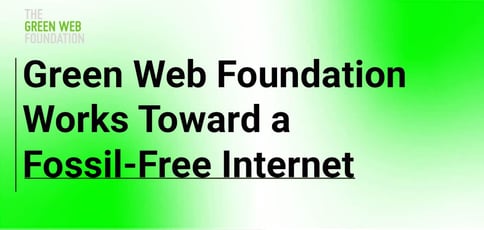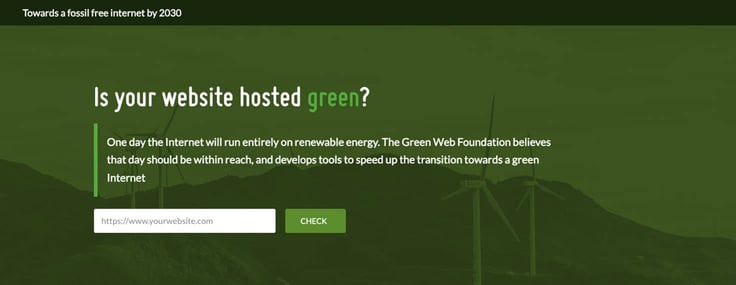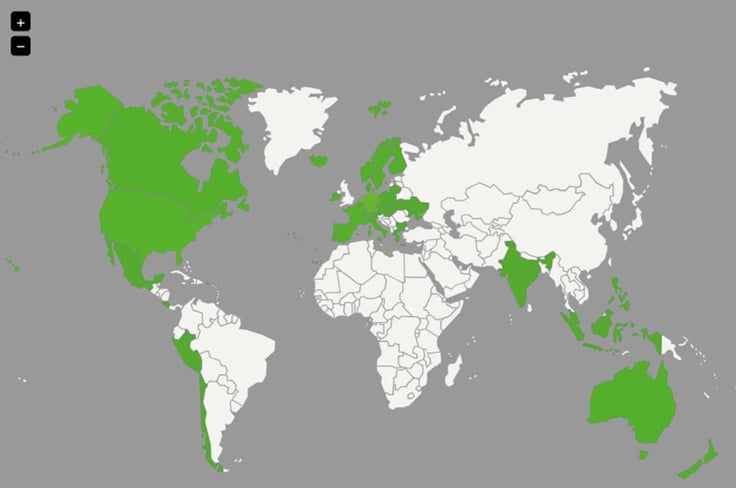
TL; DR: Web hosting is a culprit of mass carbon emissions, with yearly numbers matching those in the airline industry. Thankfully, environmental groups are tackling this issue and helping reduce the industry’s carbon footprint. The Green Web Foundation is an organization working toward a fossil-free internet and promoting the use of renewable energy within the hosting industry. Its tools help users and companies grow their carbon awareness and implement digital sustainability practices in their operations. We spoke with Chris Adams, Executive Director of The Green Web Foundation, about the team’s initiatives and upcoming projects.
What do airplanes and web hosting have in common? It may not be what you think. Although the internet operates as an invisible being for most of us, it actually releases the same amount of carbon emissions as the airline industry.
The servers that power the web’s millions of websites and applications take up 10% of global electricity consumption and produce 2% of annual global carbon emissions. Just to stream a single hour of “Stranger Things” on Netflix every week requires more energy than the yearly use of two new refrigerators.
It may seem impossible to make the internet eco-friendly and just. But it is within reach. The Green Web Foundation works with various organizations and fellows to build sustainable initiatives and shift practices for a greener future.

“We can get to a fossil-free internet by 2030 quite easily because this sector is easier to decarbonize than other sectors like agriculture or aviation. Datacenters don’t need to fly through the sky as planes do. So it becomes easier to power them on green energy as a result,” said Chris Adams, Executive Director of The Green Web Foundation.
Since 2006, The Green Web Foundation has maintained an open dataset tracking the internet’s green web hosting providers and renewable energy users. The team consists of about 10 people who work together to create digital tracking tools and initiatives to shift the narrative around sustainability.
Accelerating the Transition to a Green Internet by 2030
Before Chris joined The Green Web Foundation, he was a consumer of its platform — specifically its green web checker. He used the tool to research the internet’s most popular websites to see whether they run on green energy. Years later, he became a part of the team full time, and many new additions followed.
“We now run things like a fellowship, specifically for helping technologists understand how to embed an awareness of climate into their work. And it’s all open-source. So people blog about what they learn and create open resources for people to learn from,” said Chris.
The Green Web Foundation’s fellowship program has technologists from around the world collaborating with the project to create ideas and promote changes in policies and hosting. Providing transparency is a significant part of what The Green Web Foundation does. But Chris said the fight for a green internet isn’t only about energy but also about power.

“So you can think of the fellowship as an intervention by us to see if we can shift some of the narrative, in addition to us creating the datasets to inform the decisions companies or governments might need to make,” said Chris.
A significant challenge impeding carbon neutrality is that sustainability is not high on the list for many companies. And one reason why is that they don’t have access to the capital or resources that tech giants such as Microsoft or Google do. But in the US, the federal government is taking steps to create lists of organizations that provide green power for affordable prices.
“We are seeing promising signs now in America, Europe, and China where they are pushing for a greener grid. We still need to go three to four times faster than we currently are. But we’ve been accelerating quite impressively in the last two or three years,” said Chris.
Helping People Apply Digital Sustainability Practices
Most of The Green Web Foundation’s services are rooted in establishing transparency. Its collection of tools allows users to get the data they need to make informed decisions about hosting and other factors. While its tools play a huge role, the team also uses industry, policy, and academic involvement to press green initiatives forward.
“We can demonstrate how to apply ideas or digital sustainability into how people work. The data needs to exist in the public domain so that we can have an informed populace who can make informed decisions as policymakers, companies, and individuals,” said Chris.
One of the tools The Green Web Foundation has created, CO2.js, helps developers estimate the emissions related to their applications and websites. The team partnered with Mozilla to build the open-source JavaScript library. CO2.js enables developers to optimize for carbon just as they would optimize their software for performance.

“You can see in loads of detail which parts of a service create the environmental impact. And about 100 million people use CO2.js every day,” said Chris.
With its tools, The Green Web Foundation has helped many people implement green practices and carbon awareness into their projects. The team has also had conversations with policymakers about incorporating ideas related to green coding into their syllabi. Team members recently met up with the Internet Engineering Task Force to discuss their carbon goals and host workshops about a paper they wrote.
“We created a paper explaining and detailing how you could redesign the networking protocols to take in our carbon awareness. So when you have hops across the internet, you can have the network itself figure out which was the greenest hop to come along,” said Chris.
Filling the Gaps for a Brighter and Greener Future
The Green Web Foundation has an even greater undertaking in the works. The organization seeks to automate the progression of its open dataset to help push the internet into a greener future. The project called Carbon.txt will allow The Green Web Foundation to eliminate its process of manually checking an organization’s green energy usage.
“This currently works by organizations signing up and sharing information with us. In the long run, we realized that we want to have it so that there is no need for The Green Web Foundation to exist. But this is something that exists as part of how the internet works,” said Chris.
By automating its services, The Green Web Foundation can help make “green checking” a standard in the hosting industry. With the Carbon.txt project, users will no longer have to rely on a single provider. The team seeks to partner with other groups that publish reports and underlying evidence to build this standard protocol and scale the common dataset.
“This is one way we can achieve scale without having a single organization grow to serve the entire planet. Whereas if you can have a convention or a protocol, it can scale much faster,” said Chris.
Building a Directory for More Awareness
The web and digital services have become increasingly complex, with new technologies emerging yearly. This complexity can make it harder for users and companies to follow the supply chain of these services. The Green Web Foundation is currently developing a directory to help people become more aware of their supply chains for technology stacks.
“We are currently trialing a new directory, which is designed to allow organizations to see which parts of their technology stack are already green and which parts are not green,” said Chris.
The directory tool was a missing piece to the green checking initiative and will help many people understand the sustainability behind services, including storage, computing, networking, and databases. Once released, the directory will be visible to anyone and enable users to read their technology stacks to make informed decisions on their green usage and providers.
“If you offer digital services, please get in touch if they’re green so we can list you. And if you are curious about some of this, please express interest in Carbon.txt or our other services because we build this into a bunch of tools. So that you can audit your websites and see what changes you might need to make in the future,” said Chris.



